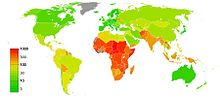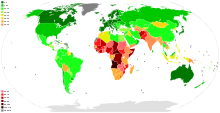User:Amraamir9/Women in Mali
Education and economic development[edit]

Education[edit]
Education is compulsory from ages six to 15. However, many children do not attend school, and girls' enrollment is lower than that of boys at all levels due to factors such as poverty, societal preference to educate boys, child marriage and sexual harassment.[1] In Malian households, the sons help with family farms, enterprises, and market purchases. They are in charge of all the major decision-making. The men are expected to acquire resources and earn the family income.[2] The daughters quickly begin doing domestic chores and caring for younger siblings. Women are expected to handle the household chores and tend to garden plots. In polygamous households, women share and split up their tasks.[2]
It is common for Malian parents to take their daughters out of school for early marriage and fear of pregnancy. There is a prevailing notion that women in Mali will engage in adultery.[3] Farming households typically keep their daughters out of schools to help with agricultural labor. Some families also fear that educated women are less likely to participate in arranged marriages and worry those women will know how to file for divorce.[4] Additionally, women are not expected to send money back to their parents. Therefore, education is not viewed as equally important for women as it is for men in Mali.[4] Once married, women are seen as the 'property' of their husbands.[3] In 1949, Malian girls only made up 21% of students enrolled in primary school. [4]
Mali's democratization in 1991 improved access to education.[4] Following the transition, girls in Mali's net enrollment in educational institutions increased by 27% by 2004 (16% to 43%).[4] However, primary school completion rates for boys and girls are 40% and 60% respectively.[4] Only 6% of girls enroll in secondary education.[4] Women's literacy rate (aged 15 and over) is significantly lower than that of men: female 22.2%, compared to male 45.1% (2015 est.).[5]
Employment[edit]
Malian women with more resources experience less employment security.[6] Factors such as higher fertility and education levels contribute to a lack of opportunities for a steady job. In Mali, increasing age, job stability of one's partner, and occupation in the agricultural sector raise women's employment security. The increase in job stability is especially true for Malian women who participate in more social situations.[6] Generally, regardless of the factors mentioned, women of childbearing age are discouraged from working and are expected to begin tending to family responsibilities.[7]
Women are greatly discriminated against in Malian workspaces. They have a low compensation, showing a difference of over 30 percent in pay packages compared to their public sector male counterparts in 2001. In the private sector, the difference was approximately 15 percent in 2001.[2]
Rural women typically take up work in the farming industry. However, their lack of resources limits their ability to store, process, and market their products. Additionally, their lack of education on proper conservation and processing leads to spoilage in seasons of high yield. These limitations result in poor economic returns.[2] Child labor is also a significant component of Malian employment. Girls typically work with women, and boys with men. Girls in rural areas tend to have larger workloads than boys and men. They are expected to do household chores in addition to their fieldwork. These chores include cooking for the family, doing laundry, and shopping on 'market days.'[8] Their farm work involves plowing fields with cows and picking plant seeds.[8] The overworking of young girls affects their education; they lack attendance and struggle with academic performance.[8]
Work in the formal sector is typically given to women in urban areas. Examples of such work include governmental careers, state-owned companies, and private enterprises.[2]
Health care[edit]


Mali is one of the world's poorest nations and is severely affected by poor health and sanitation. Women's health is negatively impacted, although the government provides subsidised medical care to children as well as adults of both sexes. The Constitution of Mali guarantees the right to health.[9] Healthcare is free for pregnant women and children up to the age of 12.[10] The healthcare policy is based on community involvement, cost recovery and the availability of essential medicines, and it is developed by the Ministry of Health and implemented by the National Health Directorate.[9] In Mali, maternal mortality and infant mortality are very high. Studies conducted by UNICEF have shown that out of 1200 women who get pregnant each day, 230 experience complications and 20 die.[10] Early marriage, lack of family planning, very high fertility, and female genital mutilation contribute to women's ill health.
Malian healthcare has improved drastically over the last fifteen years. This conclusion is drawn from improvements in child mortality rate (237% to 191%) and maternal mortality rate (582 per 100000 to 464 per 100000) between 1996 and 2006. However, life expectancy remains at 48 years old and approximately 1 in 5 children die before the age of five.[11]
There are discrepancies between rural and urban physicians. Less than 10% of Malian physicians are based in rural areas. Rural physicians have less access to technology like echographs and laboratories. These physicians typically work in community health centers and the family physicians are employed by religious/associative providers.[12] Families living in urban areas have taken up more family planning methods whereas rural families are reluctant. In such spaces children are regarded as gifts of Allah. The healthcare providers in rural areas do not give women contraceptives without their husband's permission. The village centers are generally cheap and most Malian babies are delivered there.[10] Urban areas have private practices and hospitals that are their main medical providers. The practices usually have two full-time physicians and hospitals have five. There is a prevailing issue of weak cooperation between the private and public medical sectors in Mali.[13]
Marriage[edit]

Child marriage is common in Mali, fueled by lax laws, and lack of enforcement of even the existing laws. The minimum age to marry without parental consent is 16 for girls and 18 for boys. However, this law is not enforced and earlier marriage is typical, especially in rural areas.[14] A 15-year-old girl may marry with parental consent if a civil judge approves.[15] The mean age of marriage for men and women is roughly 26 and 18, respectively.[16] The age gap is attributed to inequalities in bargaining and decision-making power.[12] Men are regarded as the head of the household and women are required by law to obey their husbands. These customs have led to many Malian women experiencing controlling behaviors from their partners (38.18%).
The culture of early marriage in Mali contributes to lesser opportunities for women. The women experience reduced access to education, employment, and independence.[12]
A Malian NGO reported that at least 10 girls-—some below the age of 13—-lost their lives between 2005 and May 2007 because of medical complications resulting from early marriage. In Mali, about 75% of girls up to age 14 and 89% of women age 15-49 are estimated to have undergone female genital mutilation (FGM), a practice which endangers their health.[13]
Interpersonal violence (IPV) in mali[edit]
Mali's geographrical location has some of the highest rates of interpersonal violence (IPV). 49% of Malian women have experienced emotional, physical, or sexual IPV. Mali does not have laws against IPV.[12] Mali has laws that legally bind Malian women to obey their husbands. Interpersonal violence is condoned in Malian society, with 76% of Malian women claiming it is justified in one or more situations.[12]
Generally, polygamous marriages increase the likelihood that women in Mali experience more than one form of interpersonal violence.[12] Polygamous marriages in Mali are reported to have weaker communication where women often experience jealousy and neglect. The need to split resources evenly induces more conflict. The risk factors for IPV are substantially higher in polygamous child marriages and monogamous marriages of older women. The monogamous marriages of older women exacerbate IPV risks because those marriages deviate from cultural norms.[12] A study conducted in 2022 shows that 37.22% of Malian women experienced physical abuse, a 10% increase since 2013. Most women in the study were under 18, middle class, and had no education.
Studies have shown varying results regarding the relationship between women's level of decision making, education, employment, and IPV. Some results show it increases the likelihood of IPV, specifically in women working outside the home, as accomplished women challenge Mali's traditional gender roles. Whereas some studies show decreased IPV as women pursue education and employment.[12]
| This is the sandbox page where you will draft your initial Wikipedia contribution.
If you're starting a new article, you can develop it here until it's ready to go live. If you're working on improvements to an existing article, copy only one section at a time of the article to this sandbox to work on, and be sure to use an edit summary linking to the article you copied from. Do not copy over the entire article. You can find additional instructions here. Remember to save your work regularly using the "Publish page" button. (It just means 'save'; it will still be in the sandbox.) You can add bold formatting to your additions to differentiate them from existing content. |
Article Draft[edit]
Lead[edit]
Article body[edit]
References[edit]
- ^ United States Department of State
- ^ a b c d e World Trade Press. Mali Society & Culture Complete Report : An All-Inclusive Profile Combining All of Our Society and Culture Reports. Petaluma: World Trade Press, 2010. Accessed October 16, 2023. ProQuest Ebook Central.
- ^ a b "Mali", Trade Profiles 2010, WTO, pp. 108–108, 2010-10-29, ISBN 978-92-870-4486-0, retrieved 2023-10-13
- ^ a b c d e f g Bleck, Jaimie (2015). Education and Empowered Citizenship in Mali. Johns Hopkins University Press. ISBN 978-1-4214-1781-3.
- ^ The World Factbook
- ^ a b Hilson, Gavin. “Family Hardship and Cultural Values: Child Labor in Malian Small-Scale Gold Mining Communities.” World development 40, no. 8 (2012): 1663–1674.
- ^ World Trade Press. Mali Society & Culture Complete Report : An All-Inclusive Profile Combining All of Our Society and Culture Reports. Petaluma: World Trade Press, 2010. Accessed October 16, 2023. ProQuest Ebook Central.
- ^ a b c Hilson, Gavin. “Family Hardship and Cultural Values: Child Labor in Malian Small-Scale Gold Mining Communities.” World development 40, no. 8 (2012): 1663–1674.
- ^ a b "Mali's Health System".
- ^ a b c World Trade Press. Mali Women in Culture, Business & Travel : A Profile of Malian Women in the Fabric of Society. Petaluma: World Trade Press, 2010. Accessed October 23, 2023. ProQuest Ebook Central.
- ^ The World Bank, Lamiaux, Mathieu, Rouzaud, Francois, and Woods, Wendy. Private Health Sector Assessment in Mali : The Post-Bamako Initiative Reality. Herndon: World Bank Publications, 2011. Accessed October 23, 2023. ProQuest Ebook Central.
- ^ a b c d e f g h Hayes, Brittany E., and Carlijn van Baak. “Intimate Partner Violence and Age at Marriage in Mali: The Moderating Influence of Polygynous Unions.” Violence against women 29, no. 6-7 (2023): 1319–1342.
- ^ a b "UNICEF Mali - Media centre - End violence, stop female genital mutilation". Archived from the original on 27 November 2018. Retrieved 26 November 2018.
- ^ Hayes, B. E., & van Baak, C. (2023). Intimate Partner Violence and Age at Marriage in Mali: The Moderating Influence of Polygynous Unions. Violence Against Women, 29(6-7), 1319-1342. https://doi-org.ezproxy.rice.edu/10.1177/10778012221108418
- ^ United States Department of State
- ^ Hayes, B. E., & van Baak, C. (2023). Intimate Partner Violence and Age at Marriage in Mali: The Moderating Influence of Polygynous Unions. Violence Against Women, 29(6-7), 1319-1342. https://doi-org.ezproxy.rice.edu/10.1177/10778012221108418
